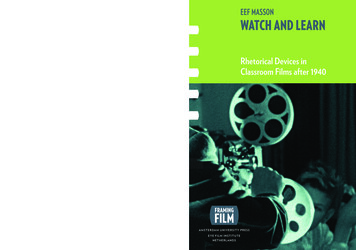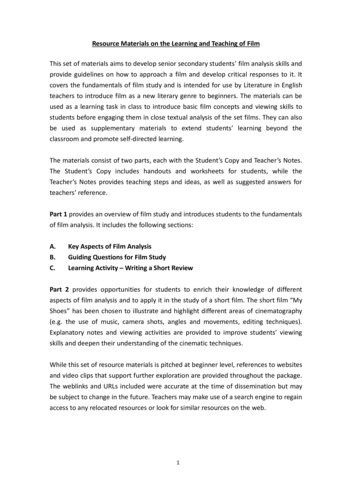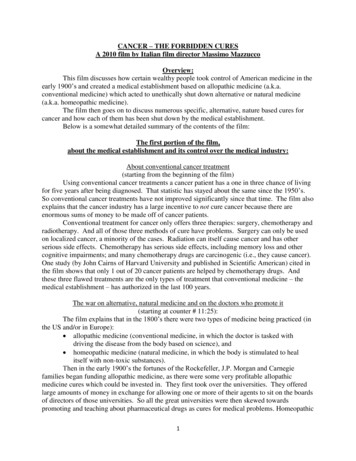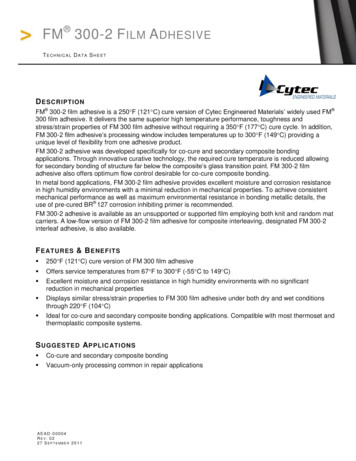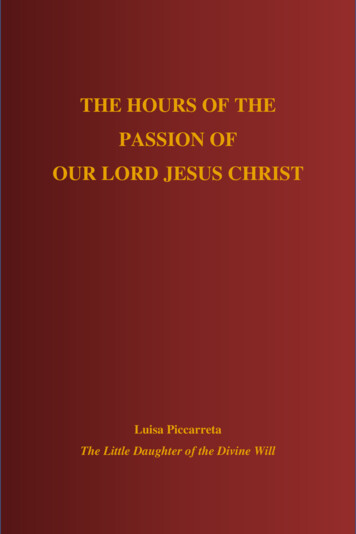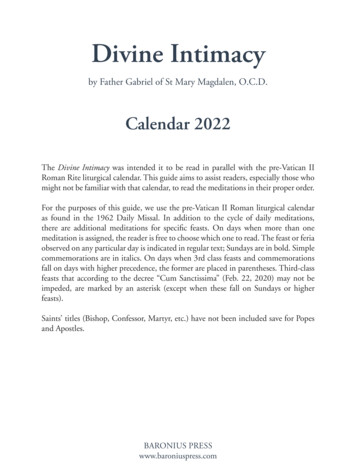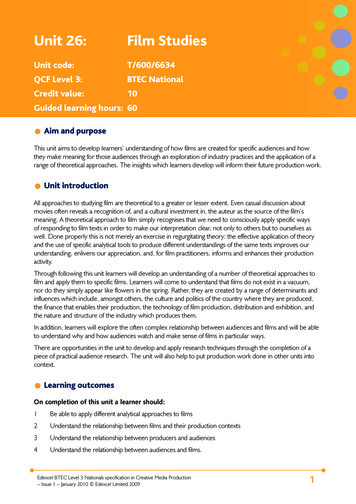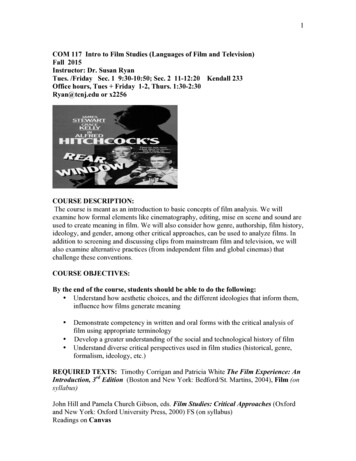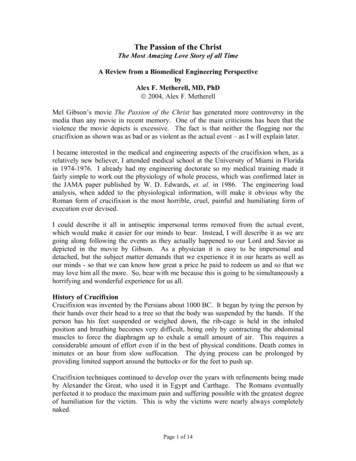
Transcription
The Passion of the ChristThe Most Amazing Love Story of all TimeA Review from a Biomedical Engineering PerspectivebyAlex F. Metherell, MD, PhD 2004, Alex F. MetherellMel Gibson’s movie The Passion of the Christ has generated more controversy in themedia than any movie in recent memory. One of the main criticisms has been that theviolence the movie depicts is excessive. The fact is that neither the flogging nor thecrucifixion as shown was as bad or as violent as the actual event – as I will explain later.I became interested in the medical and engineering aspects of the crucifixion when, as arelatively new believer, I attended medical school at the University of Miami in Floridain 1974-1976. I already had my engineering doctorate so my medical training made itfairly simple to work out the physiology of whole process, which was confirmed later inthe JAMA paper published by W. D. Edwards, et. al. in 1986. The engineering loadanalysis, when added to the physiological information, will make it obvious why theRoman form of crucifixion is the most horrible, cruel, painful and humiliating form ofexecution ever devised.I could describe it all in antiseptic impersonal terms removed from the actual event,which would make it easier for our minds to bear. Instead, I will describe it as we aregoing along following the events as they actually happened to our Lord and Savior asdepicted in the movie by Gibson. As a physician it is easy to be impersonal anddetached, but the subject matter demands that we experience it in our hearts as well asour minds - so that we can know how great a price he paid to redeem us and so that wemay love him all the more. So, bear with me because this is going to be simultaneously ahorrifying and wonderful experience for us all.History of CrucifixionCrucifixion was invented by the Persians about 1000 BC. It began by tying the person bytheir hands over their head to a tree so that the body was suspended by the hands. If theperson has his feet suspended or weighed down, the rib-cage is held in the inhaledposition and breathing becomes very difficult, being only by contracting the abdominalmuscles to force the diaphragm up to exhale a small amount of air. This requires aconsiderable amount of effort even if in the best of physical conditions. Death comes inminutes or an hour from slow suffocation. The dying process can be prolonged byproviding limited support around the buttocks or for the feet to push up.Crucifixion techniques continued to develop over the years with refinements being madeby Alexander the Great, who used it in Egypt and Carthage. The Romans eventuallyperfected it to produce the maximum pain and suffering possible with the greatest degreeof humiliation for the victim. This is why the victims were nearly always completelynaked.Page 1 of 14
Because of this, Roman citizens (with the exception of Roman soldiers who deserted)were exempt from crucifixion. (This is why Paul was not crucified.) It was reserved fornon-citizens and the worst criminals. There is little historical mention of it being appliedto women so they were also probably exempt.In 76 BC, when the Romans defeated the Spartacus slave uprising, they crucified 6,000prisoners of war along the Appian Way leading to Rome as an example and deterrent towould-be rebels.Several references are available for more details1. There is a well known analysis thatwas published in the Journal of the American Medical Association2 in 1968, whichprovides a fine description of the medical conditions but misses the engineering loadinganalysis.GethsemaneThe Passion of Christ begins at night in the Garden of Gethsemane. Jesus is prayingwhile his disciples are sleeping. This is where the suffering of Christ begins as he finallysubmits himself to the Father - “Yet not as I will, but as you will.”- and willingly takes onhimself the sin of the whole world.During this scene Satan, who is only visible to Jesus and the audience, is shown temptingJesus to not go through with his atonement. Jesus is seen kneeling in prayer with sweatdropping off His face.“And being in anguish, he prayed more earnestly, and his sweat was likedrops of blood falling to the ground.” – Luke 22:44 (NIV)This passage does not say that he sweat blood – only that it was like drops of blood.The first medical symptom - Hematidrosis: This is a rare medical condition which occursas a result of extreme stress in which the capillaries in the sweat glands break downcausing bleeding so that the sweat is tinged a pink color. The sweat drops thus containblood. The amount of bleeding is not significant. It only signifies the level of anguishJesus was experiencing at this early stage of the Passion.Gibson comes up with a stroke of cinematic genius in this same scene, in which we seeSatan giving birth to a serpent that appears from under his/her robe and slithers over toJesus as He is laying on the ground in anguished prayer. Just before this, a view ofSatan’s face had revealed something wiggling in one of Satan’s nostrils. Some think itwas a maggot, but I think it was the serpent’s tail that he/she is about to birth. Jesus getsup, oblivious to the serpent, and walking away his heel crushes the serpent’s head. Now,I would guess that only a small percentage of the Christians and none of the non1Joe Zias Crucifixion in Antiquity, http://www.centuryone.org/crucifixion2.htmlW. D. Edwards, W. J. Gabel and F. E. Hosmer. On the Physical Death of Jesus Christ JAMA, 255(11):1455-1463, March 21, 1986 For a reprint see: http://www.frugalsites.net/jesus/2Page 2 of 14
believers watching the movie would have any idea what is going on in this scene thatflashes by so quickly.This is an absolutely brilliant depiction of the fulfillment of the curse that God placed onthe serpent in Genesis 3:14-15, which is the first glimpse of God’s plan of salvation.So the Lord God said to the serpent, “Because you have done this, cursedare you above all the livestock and all the wild animals! You will crawl onyour belly and eat dust all the days of your life. And I will put enmitybetween you and the woman, and between your offspring (seed) and hers;he will crush your head and you will strike his heel.”Here we see the “seed” (Jesus) of the woman (Eve) crushing the heads of the serpent.The reference to “her seed” rather than “his (Adam’s) seed” in Gen. 3:15 is a foreshadowing of a virgin birth and Eve’s seed (Jesus) will defeat Satan. At the cross, thefulfillment of the curse is seen where Satan’s seed, through the Roman soldier, strikes theheel of Jesus as the nail is driven through the heel bone (rather than the fore-foot asshown in the movie), as I will describe later.The trialsThe betrayal, arrest and trials by Caiaphas, the Sanhedrin, Pilate, Herod Antipas and backto Pilate are all well depicted in the movie. The physical beatings during these trials areconsistent with Scripture. The character of Pilate is well portrayed. He obviously thinksthat Jesus is completely innocent and is reluctant to condemn him. As the gospelsdocument, Pilate declares on three occasions that Jesus is innocent.It was the custom at the Feast of Passover to release a prisoner whom the peoplerequested. Gibson captures the moment where Pilate brings Barabbas, a zealot who wasguilty of murder3, forward to stand next to Jesus. Barabbas is depicted as every bit a madmurderer. Barabbas’s name in Hebrew is Bar – son of, Abba – father, which means “sonof the father.” Thus when Pilate asked who should be set free, the crowd shouts“Barabbas” – “son of the father.” And, thus, the real “Son-of-the-Father” who is withoutsin is led off to die in the place of the guilty murderer, Barabbas, who is set free andgiven life. A poignant reminder that we, who are deserving of death like Barabbas, havebeen saved by this same Son-of-the-Father Jesus, who died in our place so that we maybecome a “Bar-Abba” – sons and daughters of the Father.Gibson deviates slightly, with good effect, from the Gospel account by having Jesusflogged before, instead of after, Barabbas is brought out before the crowd. In the movie,Pilate instructs his centurion to take Jesus to be flogged in the manner that was requiredpreceding a crucifixion. He orders the centurion to not allow the flogging to be so severethat it kills him and orders that Jesus be brought back to him as is documented in theGospel of John4, where he presents Jesus, wearing the crown of thorns and purple robe, tothe crowd where he one last time proclaims him innocent before sending Jesus to thecross. This artistic expression by Gibson has the effect of heightening the drama when34Matt 27:15-18; Mark 15:6,7; Luke 23:19, 25; John 19:38-39John 19:1-16Page 3 of 14
the choice is made between crucifying Jesus or Barabbas, and it shows how Pilate was arather sad, compromising politician.The scourgingThe whip (flagrum) was like a cat-and-nine-tails made of leather strips attached to a shorthandle. Iron balls and shards of broken bone were tied into the leather thongs.The bone shards had knife-like edges that slice deep into the flesh while the metal ballscause deep bruising (contusions). Each strike of the flagrum results in the bone shardsslicing through the skin and muscle. When the whip is pulled off the back the boneshards slice and rip the tissue, in some places exposing the ribs and spinous processes onthe back.Jesus was taken to the Praetorium where he would have been stripped completely naked.There his hands were bound to a whipping post. The loincloth in the movie, both in thescourging scene and the crucifixion scene, probably was not present.Scourging was required by Romans law before crucifixion. Under Roman law themaximum number of lashes that were allowed was 39. However, the Roman lictors whodid the whipping would frequently work themselves up into a cruel frenzy and exceed the39 limit, which they may have done in the case of Christ.There were two lictors standing on either side of Jesus. Each lictor alternately whippedChrist across his shoulders, back, buttocks and legs. Each blow of the flagrum was likethe claws of a lion ripping the flesh.Page 4 of 14
These wounds caused a large amount of bleeding; with blood oozing out of everylaceration. An average sized 160-pound man has about 10 pints of blood in his body5.The blood lost as a result of the scourging would have been about 4 or 5 pints. Thiswould put Christ into hypovolemic (low blood volume) shock. In this state he wouldhave difficulty standing upright and would tend to pass out. This is consistent with hisdifficulty with carrying the cross to the execution site. If the blood loss from thescourging is significantly more than this, the scourging itself would have killed him.Gibson’s depiction of this scene, gruesome as it was, was not as horrible as the reality.The cuts and marks from the whipping in the movie were not as deep nor as brutal as theyactually were. The amount of blood shown covering the flagstones on the floor of thePraetorium is consistent with what happened.Hypovolemic shock, also called cardiovascular shock, results in a low return of blood tothe heart due to the volume loss. This causes the heart to pump out a less than normalamount of blood with each beat resulting in a drop in the blood pressure (hypotension.)Normal blood pressure is about 140/80 mmHg so, depending on the amount of blood lost,the pressure might be as low as 70/zero. To maintain the pressure the heart responds bybeating as fast and as hard as it can. This is called tachycardia, where the heart ispumping at 140-160 beats per minute, similar to what happens at maximum aerobicexercise. In an athlete, this type of output is only sustainable for relatively short periods,even without volume loss. This continued the rest of the time that Christ was alive. Theheart literally exhausts itself putting itself into acute heart failure.The second physiological condition that the hypovolemic shock produces is to trigger thethirst response. The body tries to replace the loss of volume by drinking fluid. Jesus’ lastdrink had been the wine at the last supper the night before. He was intensely thirsty.The third physiological response to hypovolemic shock was that the kidneys work as hardas they can to reabsorb all the fluid being filtered through them to try to maintain thevolume. The kidneys stop making urine.The normal medical treatment for hypovolemic shock is to give the patient a bloodtransfusion. If blood is not available, then normal saline (water) is given intravenously. Ifneither of these is available drinking a large amount of water, or something like it, willwork until medical help arrives. [I know of a cardiologist who broke a leg and laceratedan artery on a camping trip in the desert and was unable to move. He had his son leave asix-pack of beer with him before going to get help. He drank the lot and it saved his life.]The Roman soldiers often taunted their condemned victims by playing the “game of theking” in which they would pretend that they were a king. They would put a makeshiftcrown on their head and put a robe on them while they took out their frustration againsttheir own authorities on the victim. Archeologists have uncovered what is believed to bethe first-century flagstone floor of the Praetorium in the Antonia Fortress where Jesuswas beaten and scourged. One of the flagstones has a cartoon of a “king” scratched in itrecording that such a game was played.5World Book Encyclopedia. Chicago: World Book, 1998: 407.Taggart, Starr and Cecie Starr. Biology: The Unity and Diversity of Life. California: Wadsworth, 1989: 398Page 5 of 14
After the scourging of Christ, the gospels record that such a cruel mocking game wasplayed on Jesus. After all, his so-called “crime” was that he claimed to be King of theJews. So they made a crown of thorns and put it on his head and placed a robe of purple,the royal color, on him “ and went up to him again and again, saying, ‘Hail, king of theJews!’ And they struck him in the face.”6 “They spit on him, and took the staff and struckhim on the head again and again. After they had mocked him, they took off the robe andput his own clothes on him. Then they led him away to crucify him.”7After being taken back to Pilate, as described earlier, the crowd still wanted himcrucified. Still proclaiming Jesus to be an innocent man, Pilate washed his hands, and letthe crowd have their way. Jesus was then led away to be crucified.The PassoverAll of this was happening on the Day of Preparation, that is the day before Passover,which, in the Jewish calendar, starts at sunset, about 6 hours away. The Day ofPreparation is the day on which the Passover meal is prepared. The head of eachhousehold takes the Passover lamb, which by tradition has been kept as a household petfor the preceding few months, and bleeds it to death by cutting its jugular veins in itsneck. So at the same moment that the Passover lambs are dying by the thousands all overIsrael, the Lamb of God – our Passover Lamb – the Lion of the Tribe of Judah – isbleeding to death for you and for me.The CrucifixionThe type of cross used in Israel at the time of Christ was a low tau cross like the letter“T.” The crossbeam (patibulum) had a notch over which a tongue projecting from thevertical post (stipes) was placed. The stipes was between 6 and 8 feet tall and waspermanently imbedded in the ground. The condemned were required to carry their cross,the patibulum alone, from the Praetorium to the crucifixion site. This is what is shown forthe two thieves who were to be crucified with Jesus. They carried the patibulum acrossthe shoulders.Gibson has said in interviews on the making of The Passion of the Christ that he went togreat lengths to keep the images in the film consistent with those depicted in the greatpaintings and sculptures of the middle ages, which have formed the images in the mindsof Christians for centuries. We have to admire him for this, for had he presented thescenes of Christ on a low tau cross it would have just “looked” wrong to us and theimpact of the movie would have been reduced.Gibson does show a scene of the two thieves on the cross where a black raven flies ontothe patibulum of the unrepentant thief and plucks his eyes out. This has caused somecontroversy among critics, but this type of thing happened regularly at crucifixion scenesin the Roman world. Because the crosses were often only 6 to 8 feet tall, the victim’s feetwould often be only one foot off the ground. Wild animals would feed on the bloodyflesh, whether the person was alive or dead. Birds of prey would also take the opportunity67John 19:3 (NIV)Matthew 27:30-31 (NIV)Page 6 of 14
to feed on the ribbons of flesh from a fresh kill. Victims’ families, if any were available,would stand vigil at the foot of the cross to drive away the wild animals and birds of prey.There is no record of such and event happening in the gospels, however, it could have,and not been deemed worthy of record. Gibson takes the biblical symbolism that blackbirds are “the evil one.8” In this scene in the film Gibson cleverly projects the idea thatthe evil thief is forever lost, while the repentant thief will that day be in paradise9 withChrist.We can see Gibson’s traditional Roman Catholic heritage most clearly coming through inthe journey from the Praetorium to “ the place of the skull (which in Aramaic is calledGolgotha).”10 The cross that Jesus is carrying is the “classic” Latin cross, with stipes andpatibulum attached. All of the events in the Stations of the Cross along the Via Dolorosaare portrayed convincingly. Simon of Cyrene11 comes off as a very real character. Thenecessity for him to carry the cross for Jesus is consistent with the hypovolemic state thatJesus was in as a result of the scourging. As he stumbled along with the cross on hisback, the lacerations on his back, which had clotted, would have been reopened by thecross rubbing on them causing more blood loss.Golgotha, “the place of the skull,” is shown in the photo below. The “eye sockets” and“nose” are clearly seen in the hill side. This is about 100 yards from the Garden tomb.The crucifixions took place at on top of the hill (about where the trees are.) This can beseen from much of the city of Jerusalem.“The Place of the Skull” – Golgotha – CalvaryPhoto by Alex MetherellWhen Christ arrived at Golgotha, theyremoved his robe and the soldiers dividedit among themselves but they cast lots forhis tunic because it was made of a singlepiece of linen. At this point, Jesus wouldhave been naked but, for obvious reasonsin the movie, he is covered with a smallloin cloth. The lacerations from thescourging would have caused bloodclotting on his garments. When thesegarments were removed some of thewounds would open up and start thebleeding again causing more blood loss.A sign (Titulus) is attached to the top of the cross of every condemned man that states thecrime for which the man is being crucified. Pilate had ordered the sign on Christ’s crossto read “JESUS OF NAZARETH, KING OF THE JEWS”12. It was written in Aramaic, Latin andGreek. The chief priests protested to Pilate saying “Do not write, ‘The King of the Jews,’8Matt 13:4, 19, 32; Mark 4:1-12, 15,32Luke 23:42-4310John 19:1711Matt 27:32. Mark 15:21. Luke 23:2612John 19:19-229Page 7 of 14
but ‘This man said, I AM KING OF THE JEWS.’”13 Pilot answered, “What I have written, Ihave written.” Not only did Pilate confirm that Jesus is King of the Jews but, ironically,the priests unwittingly confirmed it with the addition of the “I AM” suggesting that he isGod also.The cardiovascular shock would have worsened with the journey up the hill and having tocarry the cross partway. The tachycardia and induced heart failure is now beginning totake its toll. As the heart is failing under the stress, a pericardial effusion of clear strawcolored fluid begins to collect between the outside of the heart and the pericardial sac,which is a strong membrane surrounding the heart and is normally in intimate contactwith it. As this pericardial effusion increases in volume it compresses the heart andfurther impedes the heart’s ability to function properly.Since the scourging, Christ’s breathing has increased to try and keep up with oxygen andcarbon dioxide transport. There is a probable pleural effusion of a similar clear strawcolored fluid in the pleural space between the outside of the lungs and the pleura justinside the rib cage. In the upright position, as he was when he eventually was hanging onthe cross, this pleural effusion would collect in the lower part of the pleural space at thelevel of the heart. There are other biochemical changes going on in the blood associatedwith cardiovascular shock, including an increase in the acidity of the blood (acidosis),which will soon will be exacerbated further with more serious consequences.He is laid down on the cross to be nailed. The two thieves are shown being crucifiedhistorically accurately because they had only carried their patibulum (cross beam) and thestipes was already permanently in the ground. The mechanics of what happens next isthe same for all three victims. Christ’s cross is lying on the ground and he is throwndown onto the ground with his arms outstretched along the Patibulum. The dirt andgravel grind in to his wounds and the bleeding increases.The NailingIn a very dramatic and gruesome close-up, Gibson shows the first nail being driventhrough the palm of Christ’s hand. This is where centuries of artists have shown theposition of the nail so it is quite justified that Gibson shows it that way. The nail,however, was not placed there – if it had been, the load pulling on the nail by the weightof the body when it is hanging on the cross would tear through the flesh of the palmtowards the fingers until it tore out of the hand entirely. The body would fall off thecross.The only strong anchor point in the hand is through the crease in the wrist on the palmside of the hand. (See diagram) This is immediately at the end of the radius and ulnar (thebones of the forearm.) The nail is driven through the carpal tunnel. The bones of theforearm and the carpal bones of the wrist are bound by strong ligaments that make this asolid anchor point. As the nail is driven through the carpal tunnel, it crushes the mediannerve, which is the largest nerve going to the hand. The other smaller nerve is the ulnarnerve.13John 19:21 NRSVPage 8 of 14
This ulnar nerve, as it passes down thearm through the elbow, goes through thegrove on the inside of the elbow. We allknow this as the “funny bone.” It isn’tfunny and it isn’t a bone. It is the ulnarnerve, which, at one time or another, wehave all had the painful experience ofbanging on the corner of a table. Imagine,if you will, taking a pair of pliers andcrushing that ulnar nerve! The pain wouldbe unbearable.The median nerve in the carpal tunnel islarger than the ulnar so imagine it beingcrushed by the nail as shown in theillustration. This is where the Romanstook the art of torture to its highest pointby causing a maximum level of painexperienced on the cross for the wholeduration of time it takes to die. Sohorrible is this pain that they coined anew Latin word to describe it – ex, crux –out of, the cross – the English word weuse today – excruciating.Gibson correctly shows how the otherhand is nailed by stretching the arms outin a straight line along the patibulum.When the other hand is nailed in place thehands are as far apart as possible.The cross Jesus is shown being put on isthe Latin cross where the stipes andpatibulum are already assembled. Hisback is on the Stipes and the soldierpositions a foot rest (sedile) which isfastened to the stipes with a nail such thathis knees are bent in a half-knee bendposition. His feet are then nailed to thesedile.It is possible that the nail in the feet didnot go through the forefoot as shown inthe illustration. In 1968, an ossuary wasfound in Jerusalem that had an inscriptionPage 9 of 14
on the outside which read “Jehohanan the son of HGQWL.” This ossuary, dating to thetime of Christ, contained the only archeological evidence in Israel of a man who had beencrucified. The right calcaneus (heel bone) had an iron nail piercing it from the lateral tothe medial side (outside to inside.) There was still a small amount of wood from thecrucifix attached to the nail. The nail was 11.5 centimeters (4.5 inches) in length, whichmeant that it could only attach one heel to the stipes. Each foot was probably nailed oneither side of the post, rather than to the front of the post.Just because this one archeological find hasbeen made does not mean that this is how itwas done in the case of the crucifixion ofJesus. There was a lot of variation in howcrucifixions were performed. The nail couldwell have been driven through the forefoot asshown in the illustration and the traditionalpaintings of the church and it would haveaccomplished the same result.Now comes the gruesome part – gettingChrist and the two thieves upright and thestipes anchored in the ground. The legs in aPhoto Israel Museum – Israel Antiquities Authorityhalf-knee bend position cannot sustain thebody weight for more than a minute or two, even when in the best of condition. Fornearly all of the time while hanging on the cross, the weight of the body must besupported by the arms. Each arm has to produce an upward (vertical) component of forceto carry the weight of the body.Right Calcaneus (Heel Bone) with nail from1st Century Crucifixion still in PlaceThe tension force in the arm is along the direction in which the arm is pointing. Thetension in the arm produces both a vertical and horizontal component that can becalculated by the “triangle of forces” using simple vector analysis. The triangle is madeup of a vertical side, a side parallel to the arm and a horizontal side that makes up thetriangle. The lengths of the sides of the triangle are proportional to the verticalcomponent of force, the horizontal component of force and the hypotenuse that representsthe force in the arm.Page 10 of 14
If we assume the weight W of Jesus was 180-lbthen the vertical component of force on eacharm must be 90-lb.Thus, the tension load T in each arm will be:T 90 sin θ lb.As the angle θ varies from 0 to 30 degrees theforce pulling the arms starts at an infinite loadand decreases to 180-lb in each arm at 30degrees. In so doing the arms have to lengthensince the wrists are anchored at their maximumdistance apart. At the 30-degree angle each armis stretched by about 3.4 inches. Thus theshoulders and elbows joints are pulled apart.Angle of Armto Horizontal0 degrees1 degrees5 degrees10 degrees15 degrees20 degrees25 degrees30 degreesForce inArm (lb)infinite5,1431,032518348263213180Lengtheningof Arm (in.)00.0040.080.340.791.412.273.40Only by exerting extreme effort to push up on the legs can the force on the arms berelieved. Doing this transfers the weight of the body to the nails in the feet, which grindagainst the periosteum of the bone causing great pain. This is necessary to breathe. Indoing so the arms will tend to rotate at the wrist, where the square cross-section of thenail will grind on the crushed median nerve. The pain in both the wrist and feet becomesexcruciating with every breath taken.The process of dying by crucifixion is primarily that of slow suffocation. With the armsoutstretched upwards and the shoulders dislocated, the muscles and tendons of the upperarm and shoulder attach to the front, side and back rib cage as well as the collarbone. Theribs articulate (hinge) where they connect to the transverse processes of the spinalcolumn. This pulls the ribcage up into a fully inspired position. The diaphragm, whichalso plays an important part in breathing, is a dome-shaped muscle between the lungs andabdomen. The diaphragm contracts and flattens when we breathe in deeply. With theweight of the body hanging on the arms and the inability to support the weight on the legsfor more than a few seconds, the weight of the abdominal contents keeps the diaphragmsdown. Christ was in a fully inspired position.Page 11 of 14
The difficulty, therefore, is breathing out. Since the arms are fully stretched out, theycannot bend at the shoulder to pull the elbows down to allow some exhalation of air fromthe lungs. Without the ability to push up on the legs, death from complete suffocationcomes in a matter of minutes. This is why, after Jesus had died, the soldiers used thehandle of their iron spears to smash the lower legs of the thieves to prevent then frompushing up, resulting in their rapid death. (The leg bones in the ossuary of Jehohanan,described above, were broken in this manner.)The medical condition of Jesus by the time he is placed on the cross is as follows: Loss of 5 to 6 pints of blood (half of the total blood in his body) leading to:Cardiovascular (hypovolemic, hemorrhagic) shock, leading to:Raging thirst with drying of the mouth and tongue.Tachycardia leading to heart failure (exhaustion):Pulmonary distress and pleural effusion:Probable pericardial effusion:Electrolyte imbalance:Extreme weakness.Now that he is up on the cross and hypoventilating, the new problem becomes one ofoxygen and carbon dioxide exchange. The breathing response is driven more by the levelof carbon dioxide in the blood than it is by lack of oxygen. Carbon dioxide is transportedin the blood plasma as carbonic acid. Thus a major detrimental effect of inadequatebreathing is that the blood acidity increases. Some acidosis has already occurred becausewith less blood to participate in the oxygen and CO2 exchange means that more CO2 iscarried per unit volume of blood. The respiratory acidosis is now accelerating.Every time Jesus pushes up on his feet to breathe, his back slides up and down thevertical post which reopens the lacerations and more bleeding occurs.Near the end, Jesus utters14 the first verse of Psalm
The Passion of Christ begins at night in the Garden of Gethsemane. Jesus is praying while his disciples are sleeping. This is where the suffering of Christ begins as he finally submits himself to the Father - “Ye
